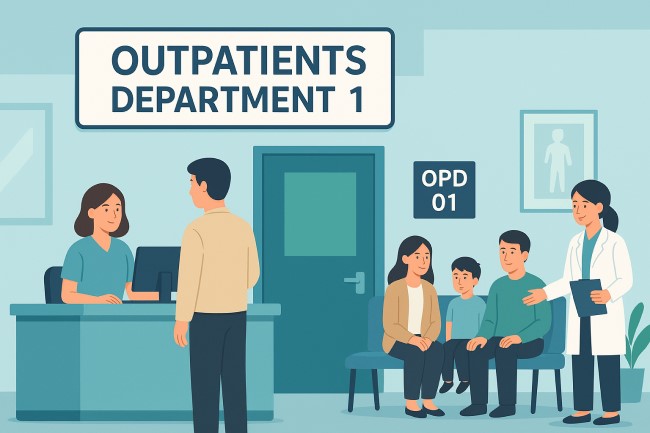Outpatients Department 1: Comprehensive Guide to Services, Structure, and Benefits

An Outpatients Department (OPD) 1 is a specialized section within a hospital or medical facility where patients receive medical consultation, diagnosis, and treatment without the need for overnight admission. The “1” typically refers to a specific unit or section within the hospital’s outpatient services, often dedicated to a particular specialty or group of related medical services. OPD 1 plays a vital role in delivering accessible, cost-effective healthcare while reducing the burden on inpatient wards.
Understanding the Role of Outpatients Department 1
What is OPD 1?
Outpatients Department 1 is often the first point of contact for individuals seeking medical attention for non-emergency conditions. It may focus on a specific medical field, such as general medicine, cardiology, or pediatrics, depending on the hospital’s structure. Patients are assessed, treated, and discharged the same day, allowing them to recover at home while maintaining regular follow-up appointments.
Why Numbering Matters in OPDs
In large hospitals, outpatient services are often divided into several numbered units (OPD 1, OPD 2, OPD 3, etc.) to manage patient flow and ensure specialized care. This system reduces overcrowding and helps direct patients to the right specialists efficiently.
Services Offered in Outpatients Department 1
General Consultation Services
-
Initial medical assessments and health check-ups.
-
Specialist consultations depending on the unit’s focus.
-
Prescriptions and treatment plans.
Diagnostic and Laboratory Tests
-
Blood tests, urine tests, and other lab services.
-
Imaging services like X-rays, ultrasounds, or ECGs.
Minor Surgical and Procedural Care
-
Small wound treatments and dressings.
-
Vaccinations and preventive care procedures.
Follow-Up and Chronic Disease Management
-
Regular monitoring for patients with ongoing medical conditions.
-
Lifestyle guidance and rehabilitation services.
Structure and Layout of OPD 1
Reception and Registration
The reception area handles patient registration, appointment scheduling, and information guidance. This is where patients are first directed to the correct clinic or consultation room.
Waiting Area
Comfortable seating with adequate space ensures patients wait in a relaxed environment. Many OPDs provide health education materials in waiting areas to inform and engage patients.
Consultation Rooms
Private rooms where doctors examine and consult with patients, ensuring confidentiality and comfort.
Support Facilities
-
Pharmacy: For on-site prescription dispensing.
-
Diagnostic Lab: For quick access to test results.
-
Nursing Station: For vital sign checks and minor care procedures.
Advantages of Outpatients Department 1
Accessibility
Patients can receive professional medical care without hospital admission, making healthcare more accessible to all age groups.
Cost-Effectiveness
OPD services generally cost less than inpatient care, making them affordable for more people.
Time Efficiency
Appointments and procedures are scheduled, reducing unnecessary delays and hospital stays.
Reduced Inpatient Load
By treating non-critical cases on an outpatient basis, hospitals free up resources for urgent and complex cases requiring hospitalization.
Importance of OPD 1 in Modern Healthcare
Patient-Centered Approach
OPD 1 focuses on individual needs, ensuring that patients get specialized care tailored to their condition.
Preventive Care and Early Detection
Many conditions, when detected early during OPD visits, can be managed before they become severe, improving long-term health outcomes.
Continuity of Care
With scheduled follow-ups, OPD 1 ensures ongoing monitoring and timely adjustments in treatment plans.
Difference Between OPD 1 and Inpatient Departments
| Feature | OPD 1 | Inpatient Department |
|---|---|---|
| Stay Duration | Same-day discharge | Overnight or longer |
| Services | Consultations, minor procedures | Intensive treatments, surgeries |
| Cost | Generally lower | Higher due to admission |
| Patient Load | Larger volume, short visits | Smaller volume, longer stays |
Best Practices in Managing OPD 1
Efficient Scheduling
Using appointment systems to manage patient flow and reduce waiting times.
Skilled Medical Staff
Hiring trained professionals who can handle high patient volumes while maintaining care quality.
Integration with Hospital Systems
Ensuring OPD records are linked with other hospital departments for seamless patient care.
Patient Education
Providing guidance on preventive healthcare and disease management during visits.
Future of Outpatients Department 1
With advances in telemedicine, digital health records, and diagnostic technology, OPD 1 is evolving into a more efficient, patient-friendly environment. In the coming years, expect more integration of virtual consultations, automated check-ins, and AI-powered diagnostic tools to enhance the patient experience.
Conclusion
Outpatients Department 1 is a cornerstone of modern healthcare, offering essential medical services without the need for hospital admission. By focusing on accessibility, affordability, and specialized care, OPD 1 ensures patients receive timely treatment and preventive health support. As healthcare technology advances, OPD 1 will continue to grow in importance, delivering even better care for communities worldwide.



